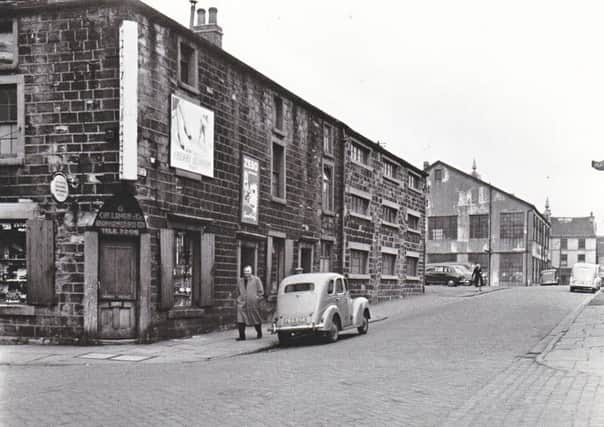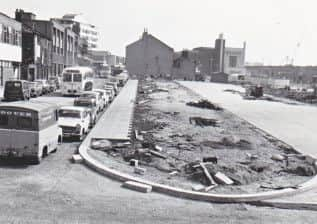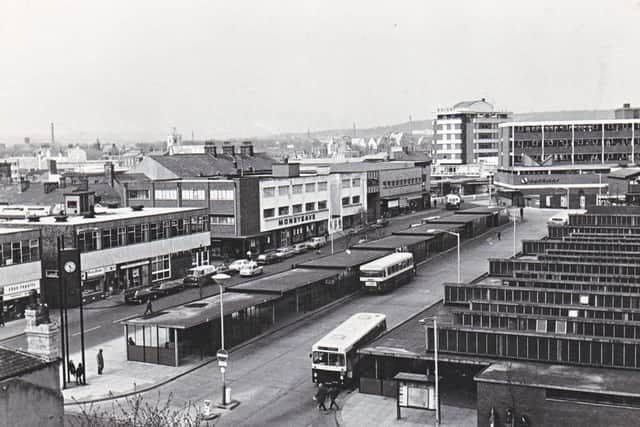How Croft Street has changed over the years


One gentleman contacted me to ask why I had not visited Barracks Road, an area of town which he associated with his younger days.
I replied that I would love to be able write articles about the Barracks Road area but the pictures I possess are not clear enough to be reproduced.
Advertisement
Hide AdAdvertisement
Hide AdMy correspondent mentioned I made a mistake in the Accrington Road article. I referred to the present takeaway, which is by the Accrington Road railway bridge, as being the one shown in Views 1 and 3 of last week’s article. I am afraid I was wrong as the takeaway is on the other side of the bridge. Apologies about that. I usually visit the sites I write about but, on this occasion, because of the weather and my belief I knew the area well enough, I did not!


A letter in Friday’s Express also mentioned the article. The writer refers to Mr Brownwood’s bookshop, which was at 88 Accrington Road. He adds that Mr Brownwood had “a sort of unofficial youth club or meeting place in the area”. A number of people have also made this observation, one of them a colleague on Burnley Council. It appears Mr Brownwood kept a room at the back of his shop where young people could meet and have a few soft drinks and biscuits. From what I have heard, Mr Brownwood’s efforts on behalf of young people are still remembered and appreciated 50 years after the kindness he showed his young neighbours.
This week we are going to look at another local street but, this time, we are going to note how it has changed over relatively recent years. We are not going to go back all that far and I am not going to bring the story up to date because, if you want to do so, all you have to do is visit the street.
The first picture shows Croft Street in Burnley centre in April, 1956. You might be able to make out the name of the firm which occupied the premises, 25 to 29, Croft Street as G. Collinge and Co (Ironmongers) Ltd. It is painted just over the door on the corner of the building.
Advertisement
Hide AdAdvertisement
Hide AdCollinge’s appear in the 1914 Commercial Directory as G. Collinge and Co commercial ironmonger at 16 Boot Street, the street leading off Croft Street to the left in the picture. The three windows on the extreme left of the Collinge building are in Boot Street. Also in 1914, numbers 27 to 29, Croft Street were occupied by Hollindrake’s, the grocer’s but, in the 1927 Directory, Collinge’s gave their address as 16 Boot Street and 25 to 29 Croft Street, so the firm was at this location for many years.


The 1893 Directory makes no mention of the firm though there are numerous mentions of members of the Collinge family. It is, after all, a name particularly associated with Cliviger, though the first references to the surname Collinge can be found in the Domesday Book of 1086 in Derbyshire and Shropshire.
I was a frequent visitor, with my father, to Collinge’s. His first job, when he left school, was at Webster’s, Burnley’s Department Store, situated in Bridge Street, though he also worked at the St James’s Street and Gannow branches, mainly in the pawn-broking department. It was there he met a man I knew as Mr Heap who, when Webster’s closed, went to work for Collinge’s at the shop shown in the picture.
The shop on the inside was very much like you might have expected it to be from the outside. To me, it was very old fashioned and I used to marvel at how Mr Heap knew where everything was. He, as were other people at the shop, was proud to be able to claim they stocked everything a customer would expect of an ironmonger. Sometimes, my father would go into the shop and ask for something pretty obscure as if to challenge Mr Heap. The latter was a friendly, genial man, who would say, rather dryly, “Oh, we have got a couple of those”. He would then disappear and re-emerge with a dirty shoe box, place it on the old counter and then open it in subdued triumph. I do not remember him failing to supply the goods until the firm moved to Plumbe Street when Croft Street was redeveloped.
Advertisement
Hide AdAdvertisement
Hide AdThe photo shows the old Collinge shop on the left. Notice that three of the windows on the ground floor still had their wooden shutters. You can see the Boot Street window still has the metal “sneck” which secured the shutters to the wall when open.
In former times many of Burnley’s shops had shutters. People think these were introduced with the coming of metal roller blinds in recent years and I have often heard people say how ugly roller blinds are and how much better was a streetscape before they were necessary. Wooden shutters were used in the past, not to keep out the wind, (their former use) but to keep out burglars of whom there were plenty in Burnley in the 18th and 19th Centuries. I think I remember shutters on the window of several premises in Church Street so am not surprised to see them here.
Two of the adverts on the wall of the premises can be read. The first is for Cherry Blossom shoe polish, which is still made, the other is for Zebo, which I remember as a black kitchen range or fire grate polish. Considering the number of ranges and grates in Burnley I am sure Zebo must have been a best seller!
There appears to be a more modern extension to the shop to the right of the older building. Beyond that, the large building at the junction of Croft Street and Yorkshire Street was built as a billiard hall, the home of Premier Billiards (Burnley) Ltd. In the Second World War it became the Victory Centre. The light-coloured build facing the top of Croft Street was one of the shops in Yorkshire Street.
Advertisement
Hide AdAdvertisement
Hide AdIt might be worthwhile to have a look at Croft Street in 1893. The side we have in the image, as we have seen, contains the odd numbers. At number 27 there was the Wheatsheaf, a beer house kept by Robert Chapples. This must have been the middle one of the three buildings on the left of the picture, the one supporting the Zebo advert.
Just above the beer house was Croft Court. This was a tiny street of very mean houses which appears to have been merely hanging on even in 1893. There were a number of such streets in this part of town and, in fact, when you see the word “Court” applied to a street name in Burnley do not expect Royal connections. Courts were usually the poorest of Burnley’s streets.
On the other side of Croft Street, where the bus station is now, there were lots of small businesses. These included the Parker’s Arms, which, in 1893, was kept by Charles Chew. Other businesses included a hawker, he sold his goods door to door or on the streets, a shopkeeper, fish dealer and cab proprietor.
If we turn to the second picture we can see what was happening to Croft Street only a few years after the first picture was taken. Most of the lower part of the even side of the street has gone to make way for the bus station which opened in June 1964. Here you see, from left to right, the new pavement in Croft Street, a plot of undeveloped land which was to house bus shelters and then the through road built to accommodate the buses of the Burnley, Colne and Nelson Joint Transport Undertaking.
Advertisement
Hide AdAdvertisement
Hide AdOn the odd side of Croft Street, notice the Collinge building is still there and the two advertising hoardings can still be seen on the Croft Street elevation. In the distance you can see that the Keirby Hotel is almost complete so this picture can be dated to c1959.
The third picture shows Burnley Bus Station in full swing. Unfortunately, I have no date for this image but it must have been taken in the late 1960s. As indicated, the bus station opened in 1964 but Safeway’s, the supermarket which occupied the ground floor of the old Inland Revenue building, did not arrive until a little later. You will be able to see that Safeway’s are in occupation. The building was later taken over by the housing association Calico, who have made improvements to what was a pretty bland building.
You will see that the Collinge building has gone and the site is now occupied by Moneysave, another supermarket. On the other side of Boot Street you can see the Concorde which I recall as the Inn Place (or was it the Inn Plaice?) which I used to frequent as it was possible to get a meal there when I was lecturing in the evening at Burnley College or Towneley School.
I wonder if many of you remember Percy Brown’s, the fish shop, at the location you can see (just to the right of the public clock) here in Croft Street? Until I examined the photo for this article I had forgotten that Brown’s had these premises. As a boy I was interested in fish shops and disappointed Burnley appeared to have so few. There was a proper fish market in Blackburn but I was used to the fish shops of Whitehaven which we visited when we were on holiday.
Advertisement
Hide AdAdvertisement
Hide AdBrown’s made a good stab at the sort of displays I was used to seeing in Blackburn and at the fish shops of King Street in Whitehaven but even these did not compare to the sight of landing the fish at Whitehaven docks. It was possible to approach a trawler owner, offer him something for a box of fish and the deal was done. You never quite knew what you were going to get but the price was an absolute bargain.
With that we must leave Croft Street. As you can see, it has changed considerably in my own lifetime and, with the present bus station, has changed yet again. It needs more investment to get rid of the dreadful buildings erected in the 1960s, some of which you can see in these pictures. I have often thought they do not give a good impression of Burnley for those arriving in town by bus but there does not appear to be much progress in getting rid of them even though some of the buildings are empty and unlikely to be occupied again.